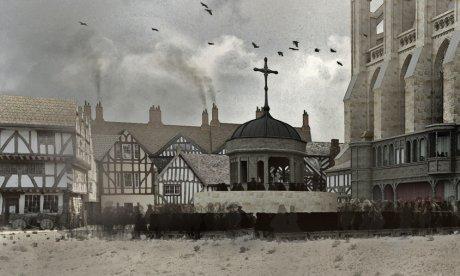Blog
ODH in the News
November 19, 2013

Photo caption
Paul’s Churchyard, looking east from the west. From the Visual Model, courtesy of the Virtual Paul’s Cross Project.
Constructed by Joshua Stephens, rendered by Jordan Grey.

Photo caption
Paul’s Churchyard, looking east from the west. From the Visual Model, courtesy of the Virtual Paul’s Cross Project.
Constructed by Joshua Stephens, rendered by Jordan Grey.
Several projects funded by NEH's Office of Digital Humanities have been featured in the news recently. Some highlights include:
- Could the crowd gathered around John Donne at St. Paul's Cross in the 17th century even hear his sermons? This was the core question that led John Wall, a professor of English at North Carolina State University, to apply for an NEH Start-Up Grant in support of The Virtual Paul's Cross Project. The Guardian recently profiled the results of Wall's research, which included creating a visual model of the area (the original burned down in the great London fire of 1666), complete with an acoustic profile. As The Guardian reports, Wall learned that while "we know that large crowds showed up to hear Donne's sermons, […]it was unclear whether they could even hear what was being said. By using the models we created for this project, we learned that the courtyard space allowed sound to reverberate, amplifying the voice of the speaker." In addition to the videos featured on The Guardian's website, Wall's project website offers additional details about the process for creating the physical and acoustic models, and the full sound for Donne's 1622 Gunpowder Day sermon performed by a professional voice specialist.
- Greg Miller, the Senior Science Writer at Wired, recently featured the "Infectious Texts" Start-Up Grant project on the Wired MapLab blog. We recently posted a Q&A with Ryan Cordell, project director of "Uncovering Reprinting Networks in Nineteenth-Century American Newspapers," who is working with collaborators Elizabeth Maddock Dillon and David Smith of Northeastern University's NULab for Texts, Maps, and Networks, to explore how stories, poems, and news items circulated among American newspapers in the 1800s. Miller's Wired piece highlights the project's use of mapping to highlight circulation of stories and the spread of newspapers, and includes several videos of these geographic visualizations.
- Popular Science profiled a unique collaboration between medical doctors, scientists, anthropologists, and archaeologists on the topic of mummies in its recent article, "How Studying Mummies Could Cure Modern Diseases." The IMPACT Radiological Mummy Database, which developed a large-scale comparative database of medical imaging of mummified human remains, was jointly funded by the NEH and the Canadian Social Sciences and Humanities Research Council (SSHRC) in the second round of the Digging into Data program. Instead of approaching each mummy individually, the project team can now perform cross-cultural and cross-temporal studies of these unique remains using whole-body CT scans and DNA sequencing. As the Popular Science article highlights, the project team has already discovered that "atherosclerosis—a dangerous artery hardening that can lead to heart attacks or stroke" occurred in "34 percent of" the 137 mummies. Even more significantly, they found that the condition "afflicted mummies from every group," which includes "ancient Egyptians and Peruvians, ancestral Puebloans of southwest America, and Unangan hunter-gatherers of the Aleutian Islands." The article goes on to discuss other discoveries in this collaborative project.
- Finally, NEH's own Humanities Magazine Writer/Editor Meredith Hindley profiled the Mapping the Republic of Letters project, which won a 2009 Digging into Data grant to explore the network of correspondence between "the loose grouping of learned men and women who comprised Europe’s intellectual community" in the 18th century. The project team recently received a Digital Humanities Implementation Grant in order to expand the tools and make them available to a broader base of researchers. As Hindley notes, "Although it was clearly a digital project, Edelstein says they began with fairly traditional questions about the Republic of Letters, some that people had been asking for decades. 'Did the reality match the rhetoric of the Republic of Letters? Really, how global and cosmopolitan were these networks? Was there one network? Or were there lots of little networks that weren’t connected?' he asks." Be sure to read the article to learn more about the research questions and the tools being developed by the project team.
- Bonus track: if you haven't read Meredith Hindley's earlier Humanities article about digital humanities work in the earliest years of NEH's history, it's worth it: The Rise of the Machines: NEH AND THE DIGITAL HUMANITIES: THE EARLY YEARS.